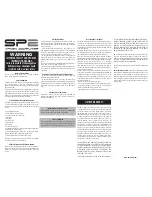
NOVUS AUTOMATION
www.fieldlogger.net
75/104
REMOTE CHANNELS
Function not available in models “
FieldLogger – USB, 512k logs, RS485
” and “
FieldLogger – USB,
512k logs, RS485, 24 V
”.
FieldLogger
can act as a master of a Modbus RTU network (please check the RS485 interface configuration), being
able to read up to 64 registers from other devices (Modbus slaves) and using these registers as inputs in the virtual
channels, alarms and loggings. Each one of these registers read from other slaves is called a "remote channel".
The equipment starts reading the channels in the same order that they were created at configuration time. It goes on
reading all channels, respecting the times between commands, until it has read them all. When the scan interval has
elapsed, it restarts the readings of all remote channels. In case the channels scan takes longer than the settled scan
interval, it restarts the channels reading immediately.
If the slave takes longer than the configured time out to respond, this will be considered a communication error. In the
same way, response packets with invalid CRCs or with times between bytes greater than those specified in the Modbus
standard will be considered communication errors. In the occurrence of a communication error in a remote channel
reading, it tries again until the configured number of attempts has been reached. If the error persists, the error value
configured for the channel is assumed.
The whole communication flow can be monitored by the
FieldLogger
Tx and Rx LEDs. Whenever a command is sent to
a slave, the Tx led turns ON. When the slave responds to the command, the Rx led turns ON. This way, during a normal
FieldLogger
scan of some slaves, Tx and Rx LEDs should flash alternately as many times as the number of the
configured remote channels.
From firmware version 1.50 on, it is possible to assign a number of decimal places directly to the remote channels. This
way it is not necessary to use virtual channels to view a remote channel which has one or more decimal places. For
example, reading a temperature from a Modbus slave that has a decimal place in integer format, in other words, it is
multiplied by “10” (25.7 ºC is read as 257), it is possible to read “25.7” directly. In older versions, you had to create a
virtual channel that received this remote channel and divided its value by 10, restoring the original temperature value.
This virtual channel could then be used to replace the remote channel for logging, alarms or simple indication.
VIRTUAL CHANNELS
There are up to 128 virtual channels available in the
FieldLogger
. These channels are nothing more than channels
whose values are the result of logical or mathematical operations. Depending on the selected operation, one or two
operands will be necessary, defining that the operands are always other channels (analog, digital, remote or even
virtual). All operands are in the "floating point" format, which allows a greater precision in the calculations by the use of
several decimal places.
It is possible to “chain” several operations, causing the outcome of an operation to be the operand of another. If a
channel used as operand is in an error condition, the resulting virtual channel will also assume its own error value. In
other words, the error condition is passed on to the virtual channels that are dependent on a channel in error.
Constant values can be used through the "Constant" operation, where a value chosen by the user may be assigned to a
virtual channel.
The following operations are available and can be used:
Operation
Number of
Operands
Function
Constant
1
Assigns a value to the virtual channel. Example: VC = 123.67
Addition
2
It receives the addition from two channels. Example: VC = C1 + C2
Subtraction
2
Receives the subtraction from two channels. Example: VC = C1 - C2
Multiplication
2
Receives the multiplication from two channels. Example: VC = C1 * C2
Division
2
It receives the division from two channels. Example: VC = C1 / C2
Logical “And”
2
It receives “0” if at least one of the two channels is zero. It receives “1” if
both channels are different from zero.
Logical “OR”
2
It receives “0” if at least one of the two channels is not zero. It receives
“0” if both channels are equal to zero.
Logical “Exclusive OR”
2
It receives “1” if only one of the two channels is not zero. It receives “0”
if both channels are equal to zero or if both are different from zero.
FloatToFloat
2
Transforms two 16-bit values in a “float”. Typically used when reading
two Modbus registers (remote channels) from other device that, when
combined, represent a floating point value.
Int32ToFloat
2
Transforms an integer 32-bit signaled value in a floating point value.
The allowable range for the integer value (operand) is from -16777215
to 16777215. Values outside this range will suffer truncation.
Square Root
1
Receives the square root from the operand (source channel).
















































